SBM4101: Foundations of Information Systems - Xero Analysis Report
VerifiedAdded on 2023/03/17
|16
|4293
|97
Report
AI Summary
This report provides a comprehensive analysis of Xero's information systems, focusing on how these systems support its business strategies and contribute to its competitive advantage. The report begins with an introduction to information systems and their importance, followed by a detailed description of Xero, a cloud-based accounting software company, and the selection of ERP (Enterprise Resource Planning) as a key information system product. The core of the report examines how information systems are vital for supporting business strategies and achieving competitive benefits, contributing to organizational success, and enhancing decision-making. The analysis then identifies and evaluates three alternative information system solutions: Transaction Processing System (TPS), Management Information System (MIS), and Executive Information System (EIS), detailing their relevant aspects and viability for Xero. The report also discusses the distinctions between in-house development and outsourcing elements in Xero, justifying the major requirements and needs of information systems within the company. Finally, the report justifies the selection of the chosen information system product for the project and concludes with a summary of the key findings and recommendations.
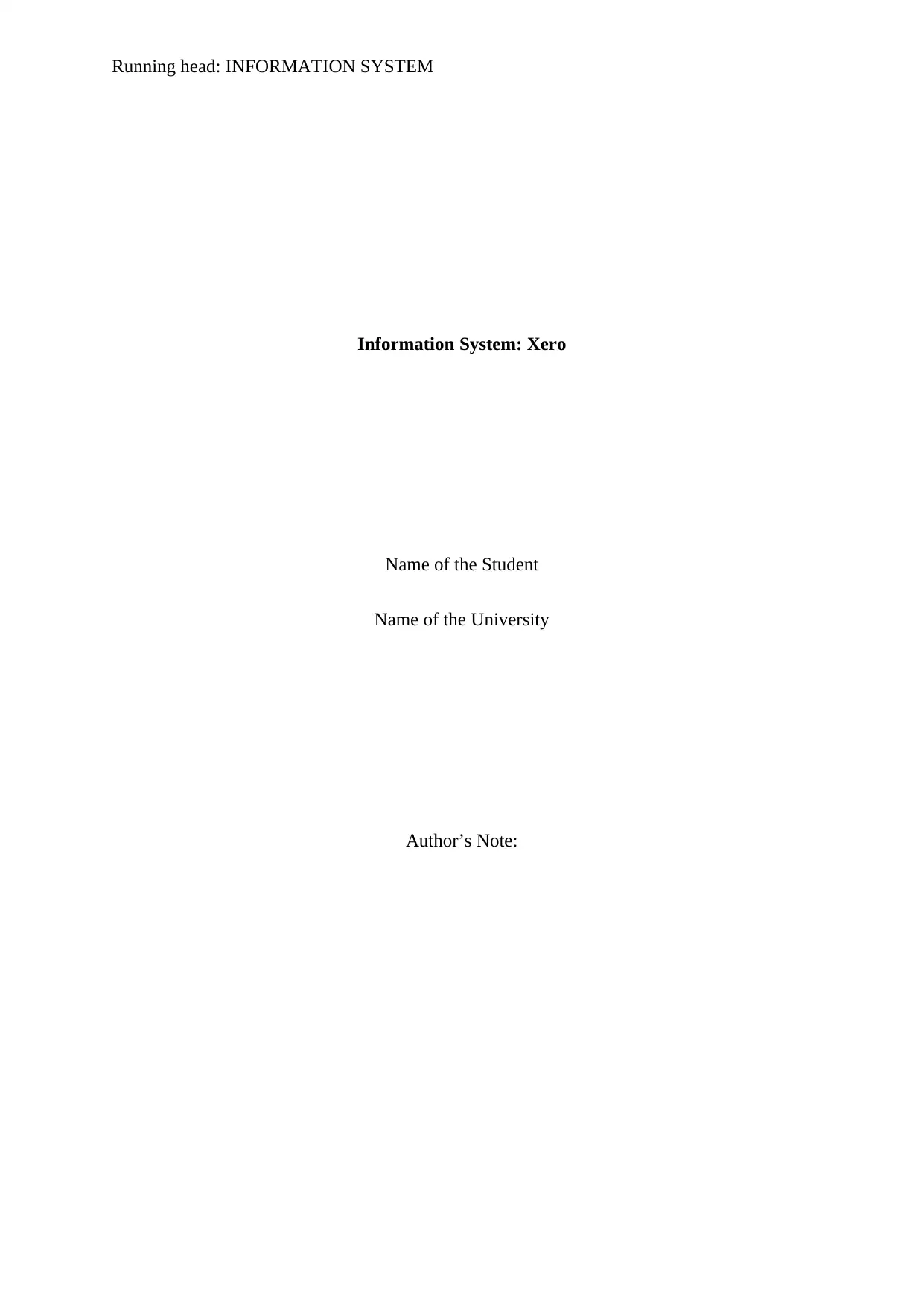
Running head: INFORMATION SYSTEM
Information System: Xero
Name of the Student
Name of the University
Author’s Note:
Information System: Xero
Name of the Student
Name of the University
Author’s Note:
Paraphrase This Document
Need a fresh take? Get an instant paraphrase of this document with our AI Paraphraser
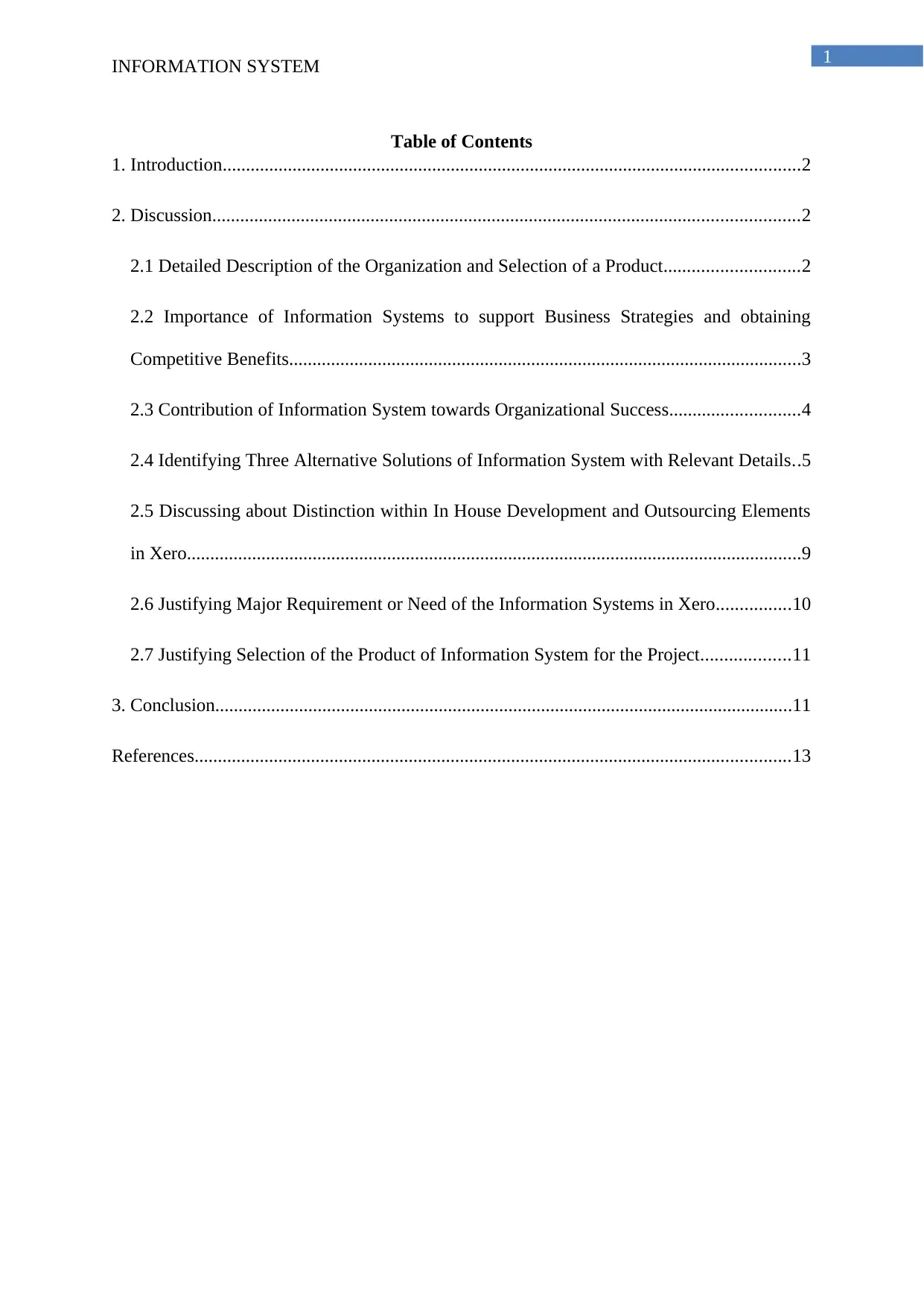
1
INFORMATION SYSTEM
Table of Contents
1. Introduction............................................................................................................................2
2. Discussion..............................................................................................................................2
2.1 Detailed Description of the Organization and Selection of a Product.............................2
2.2 Importance of Information Systems to support Business Strategies and obtaining
Competitive Benefits..............................................................................................................3
2.3 Contribution of Information System towards Organizational Success............................4
2.4 Identifying Three Alternative Solutions of Information System with Relevant Details..5
2.5 Discussing about Distinction within In House Development and Outsourcing Elements
in Xero....................................................................................................................................9
2.6 Justifying Major Requirement or Need of the Information Systems in Xero................10
2.7 Justifying Selection of the Product of Information System for the Project...................11
3. Conclusion............................................................................................................................11
References................................................................................................................................13
INFORMATION SYSTEM
Table of Contents
1. Introduction............................................................................................................................2
2. Discussion..............................................................................................................................2
2.1 Detailed Description of the Organization and Selection of a Product.............................2
2.2 Importance of Information Systems to support Business Strategies and obtaining
Competitive Benefits..............................................................................................................3
2.3 Contribution of Information System towards Organizational Success............................4
2.4 Identifying Three Alternative Solutions of Information System with Relevant Details..5
2.5 Discussing about Distinction within In House Development and Outsourcing Elements
in Xero....................................................................................................................................9
2.6 Justifying Major Requirement or Need of the Information Systems in Xero................10
2.7 Justifying Selection of the Product of Information System for the Project...................11
3. Conclusion............................................................................................................................11
References................................................................................................................................13
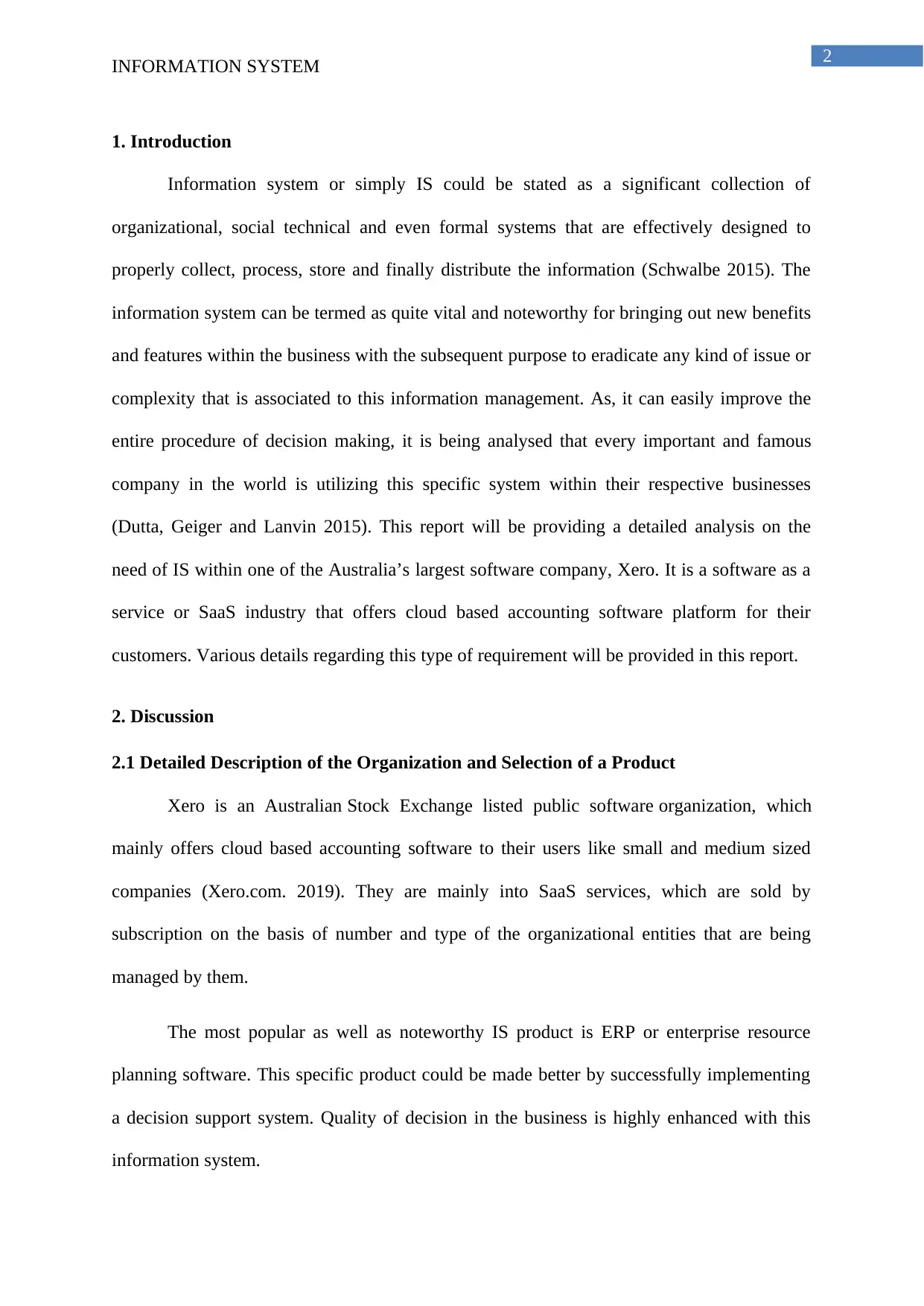
2
INFORMATION SYSTEM
1. Introduction
Information system or simply IS could be stated as a significant collection of
organizational, social technical and even formal systems that are effectively designed to
properly collect, process, store and finally distribute the information (Schwalbe 2015). The
information system can be termed as quite vital and noteworthy for bringing out new benefits
and features within the business with the subsequent purpose to eradicate any kind of issue or
complexity that is associated to this information management. As, it can easily improve the
entire procedure of decision making, it is being analysed that every important and famous
company in the world is utilizing this specific system within their respective businesses
(Dutta, Geiger and Lanvin 2015). This report will be providing a detailed analysis on the
need of IS within one of the Australia’s largest software company, Xero. It is a software as a
service or SaaS industry that offers cloud based accounting software platform for their
customers. Various details regarding this type of requirement will be provided in this report.
2. Discussion
2.1 Detailed Description of the Organization and Selection of a Product
Xero is an Australian Stock Exchange listed public software organization, which
mainly offers cloud based accounting software to their users like small and medium sized
companies (Xero.com. 2019). They are mainly into SaaS services, which are sold by
subscription on the basis of number and type of the organizational entities that are being
managed by them.
The most popular as well as noteworthy IS product is ERP or enterprise resource
planning software. This specific product could be made better by successfully implementing
a decision support system. Quality of decision in the business is highly enhanced with this
information system.
INFORMATION SYSTEM
1. Introduction
Information system or simply IS could be stated as a significant collection of
organizational, social technical and even formal systems that are effectively designed to
properly collect, process, store and finally distribute the information (Schwalbe 2015). The
information system can be termed as quite vital and noteworthy for bringing out new benefits
and features within the business with the subsequent purpose to eradicate any kind of issue or
complexity that is associated to this information management. As, it can easily improve the
entire procedure of decision making, it is being analysed that every important and famous
company in the world is utilizing this specific system within their respective businesses
(Dutta, Geiger and Lanvin 2015). This report will be providing a detailed analysis on the
need of IS within one of the Australia’s largest software company, Xero. It is a software as a
service or SaaS industry that offers cloud based accounting software platform for their
customers. Various details regarding this type of requirement will be provided in this report.
2. Discussion
2.1 Detailed Description of the Organization and Selection of a Product
Xero is an Australian Stock Exchange listed public software organization, which
mainly offers cloud based accounting software to their users like small and medium sized
companies (Xero.com. 2019). They are mainly into SaaS services, which are sold by
subscription on the basis of number and type of the organizational entities that are being
managed by them.
The most popular as well as noteworthy IS product is ERP or enterprise resource
planning software. This specific product could be made better by successfully implementing
a decision support system. Quality of decision in the business is highly enhanced with this
information system.
⊘ This is a preview!⊘
Do you want full access?
Subscribe today to unlock all pages.

Trusted by 1+ million students worldwide
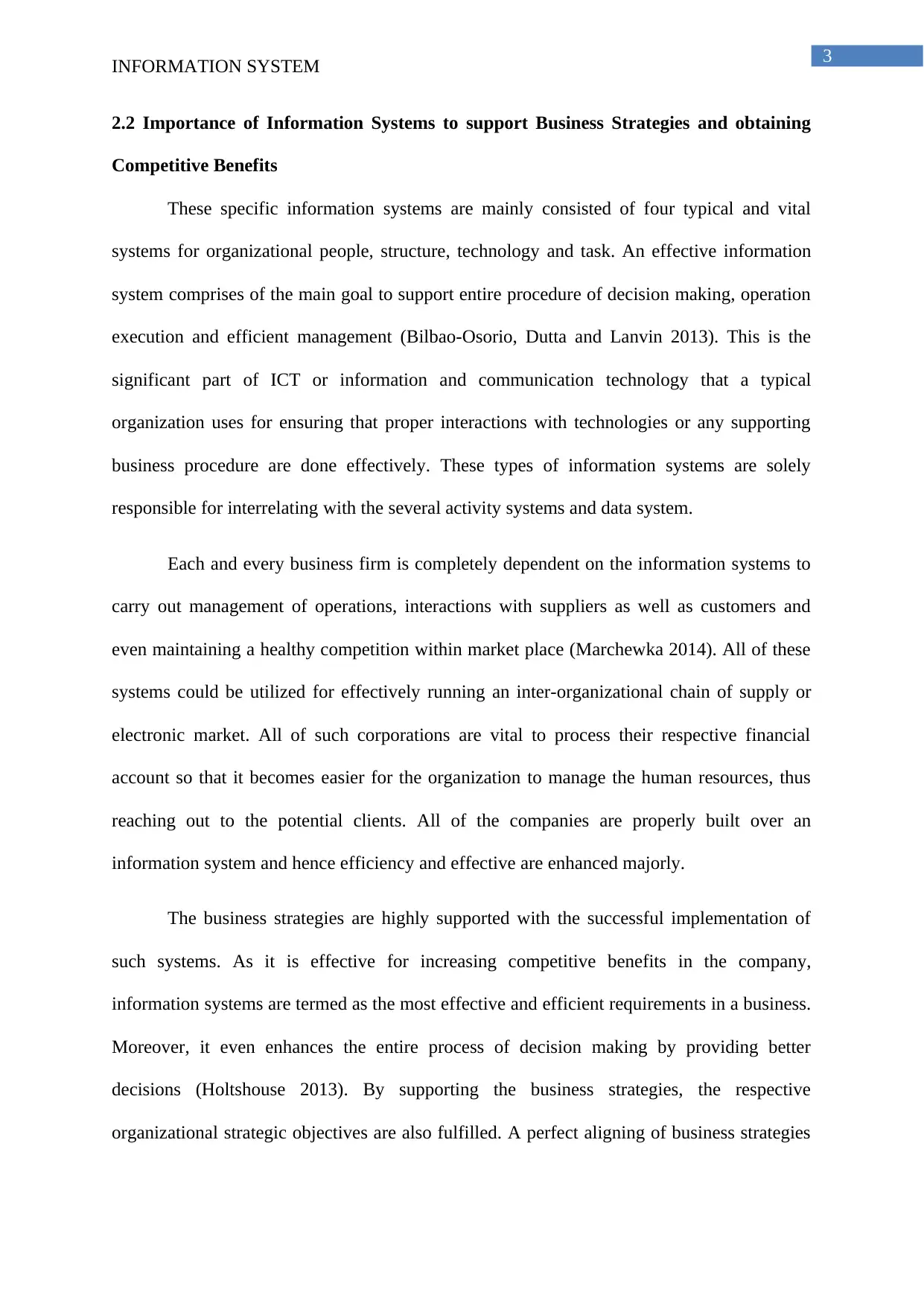
3
INFORMATION SYSTEM
2.2 Importance of Information Systems to support Business Strategies and obtaining
Competitive Benefits
These specific information systems are mainly consisted of four typical and vital
systems for organizational people, structure, technology and task. An effective information
system comprises of the main goal to support entire procedure of decision making, operation
execution and efficient management (Bilbao-Osorio, Dutta and Lanvin 2013). This is the
significant part of ICT or information and communication technology that a typical
organization uses for ensuring that proper interactions with technologies or any supporting
business procedure are done effectively. These types of information systems are solely
responsible for interrelating with the several activity systems and data system.
Each and every business firm is completely dependent on the information systems to
carry out management of operations, interactions with suppliers as well as customers and
even maintaining a healthy competition within market place (Marchewka 2014). All of these
systems could be utilized for effectively running an inter-organizational chain of supply or
electronic market. All of such corporations are vital to process their respective financial
account so that it becomes easier for the organization to manage the human resources, thus
reaching out to the potential clients. All of the companies are properly built over an
information system and hence efficiency and effective are enhanced majorly.
The business strategies are highly supported with the successful implementation of
such systems. As it is effective for increasing competitive benefits in the company,
information systems are termed as the most effective and efficient requirements in a business.
Moreover, it even enhances the entire process of decision making by providing better
decisions (Holtshouse 2013). By supporting the business strategies, the respective
organizational strategic objectives are also fulfilled. A perfect aligning of business strategies
INFORMATION SYSTEM
2.2 Importance of Information Systems to support Business Strategies and obtaining
Competitive Benefits
These specific information systems are mainly consisted of four typical and vital
systems for organizational people, structure, technology and task. An effective information
system comprises of the main goal to support entire procedure of decision making, operation
execution and efficient management (Bilbao-Osorio, Dutta and Lanvin 2013). This is the
significant part of ICT or information and communication technology that a typical
organization uses for ensuring that proper interactions with technologies or any supporting
business procedure are done effectively. These types of information systems are solely
responsible for interrelating with the several activity systems and data system.
Each and every business firm is completely dependent on the information systems to
carry out management of operations, interactions with suppliers as well as customers and
even maintaining a healthy competition within market place (Marchewka 2014). All of these
systems could be utilized for effectively running an inter-organizational chain of supply or
electronic market. All of such corporations are vital to process their respective financial
account so that it becomes easier for the organization to manage the human resources, thus
reaching out to the potential clients. All of the companies are properly built over an
information system and hence efficiency and effective are enhanced majorly.
The business strategies are highly supported with the successful implementation of
such systems. As it is effective for increasing competitive benefits in the company,
information systems are termed as the most effective and efficient requirements in a business.
Moreover, it even enhances the entire process of decision making by providing better
decisions (Holtshouse 2013). By supporting the business strategies, the respective
organizational strategic objectives are also fulfilled. A perfect aligning of business strategies
Paraphrase This Document
Need a fresh take? Get an instant paraphrase of this document with our AI Paraphraser
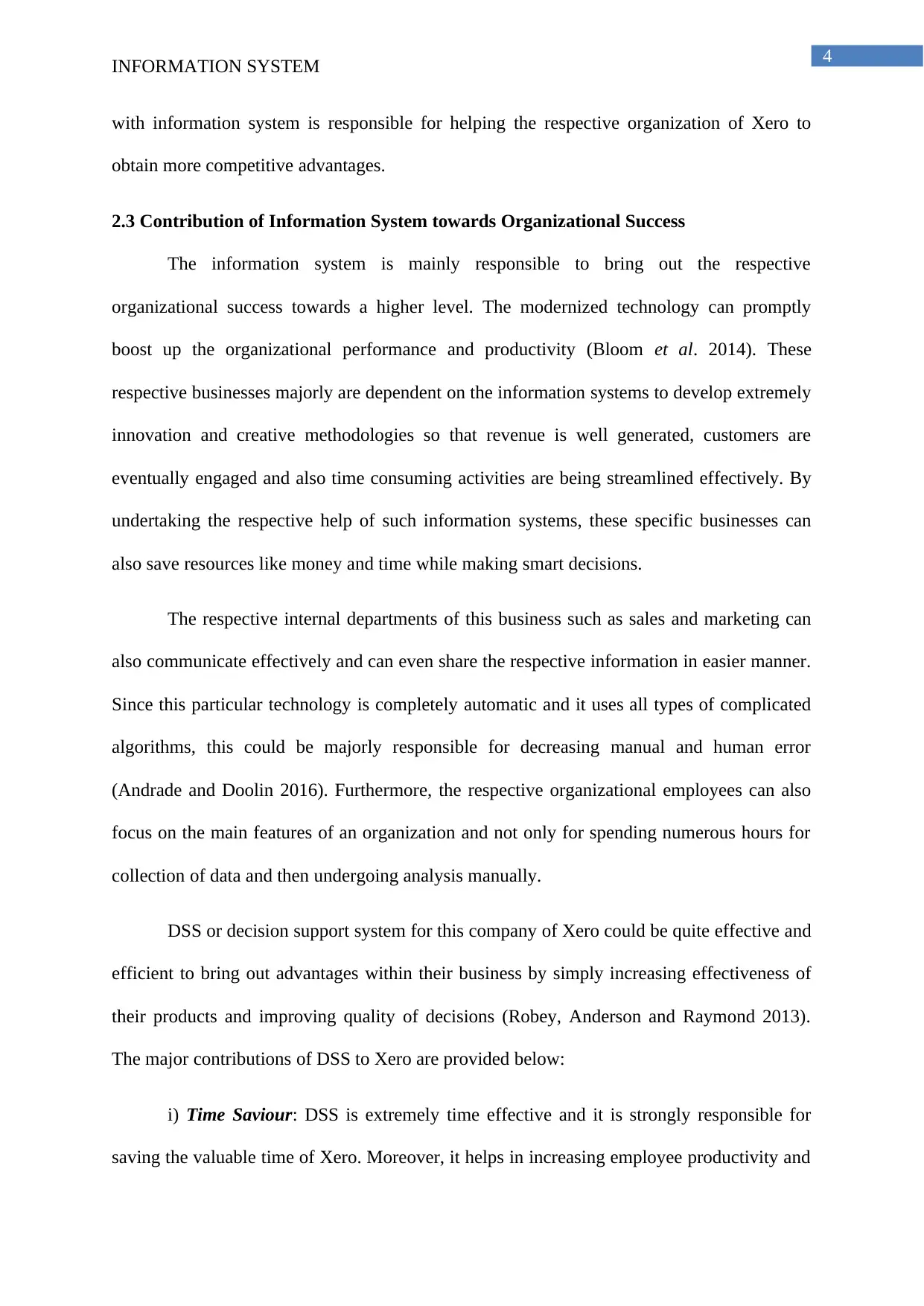
4
INFORMATION SYSTEM
with information system is responsible for helping the respective organization of Xero to
obtain more competitive advantages.
2.3 Contribution of Information System towards Organizational Success
The information system is mainly responsible to bring out the respective
organizational success towards a higher level. The modernized technology can promptly
boost up the organizational performance and productivity (Bloom et al. 2014). These
respective businesses majorly are dependent on the information systems to develop extremely
innovation and creative methodologies so that revenue is well generated, customers are
eventually engaged and also time consuming activities are being streamlined effectively. By
undertaking the respective help of such information systems, these specific businesses can
also save resources like money and time while making smart decisions.
The respective internal departments of this business such as sales and marketing can
also communicate effectively and can even share the respective information in easier manner.
Since this particular technology is completely automatic and it uses all types of complicated
algorithms, this could be majorly responsible for decreasing manual and human error
(Andrade and Doolin 2016). Furthermore, the respective organizational employees can also
focus on the main features of an organization and not only for spending numerous hours for
collection of data and then undergoing analysis manually.
DSS or decision support system for this company of Xero could be quite effective and
efficient to bring out advantages within their business by simply increasing effectiveness of
their products and improving quality of decisions (Robey, Anderson and Raymond 2013).
The major contributions of DSS to Xero are provided below:
i) Time Saviour: DSS is extremely time effective and it is strongly responsible for
saving the valuable time of Xero. Moreover, it helps in increasing employee productivity and
INFORMATION SYSTEM
with information system is responsible for helping the respective organization of Xero to
obtain more competitive advantages.
2.3 Contribution of Information System towards Organizational Success
The information system is mainly responsible to bring out the respective
organizational success towards a higher level. The modernized technology can promptly
boost up the organizational performance and productivity (Bloom et al. 2014). These
respective businesses majorly are dependent on the information systems to develop extremely
innovation and creative methodologies so that revenue is well generated, customers are
eventually engaged and also time consuming activities are being streamlined effectively. By
undertaking the respective help of such information systems, these specific businesses can
also save resources like money and time while making smart decisions.
The respective internal departments of this business such as sales and marketing can
also communicate effectively and can even share the respective information in easier manner.
Since this particular technology is completely automatic and it uses all types of complicated
algorithms, this could be majorly responsible for decreasing manual and human error
(Andrade and Doolin 2016). Furthermore, the respective organizational employees can also
focus on the main features of an organization and not only for spending numerous hours for
collection of data and then undergoing analysis manually.
DSS or decision support system for this company of Xero could be quite effective and
efficient to bring out advantages within their business by simply increasing effectiveness of
their products and improving quality of decisions (Robey, Anderson and Raymond 2013).
The major contributions of DSS to Xero are provided below:
i) Time Saviour: DSS is extremely time effective and it is strongly responsible for
saving the valuable time of Xero. Moreover, it helps in increasing employee productivity and
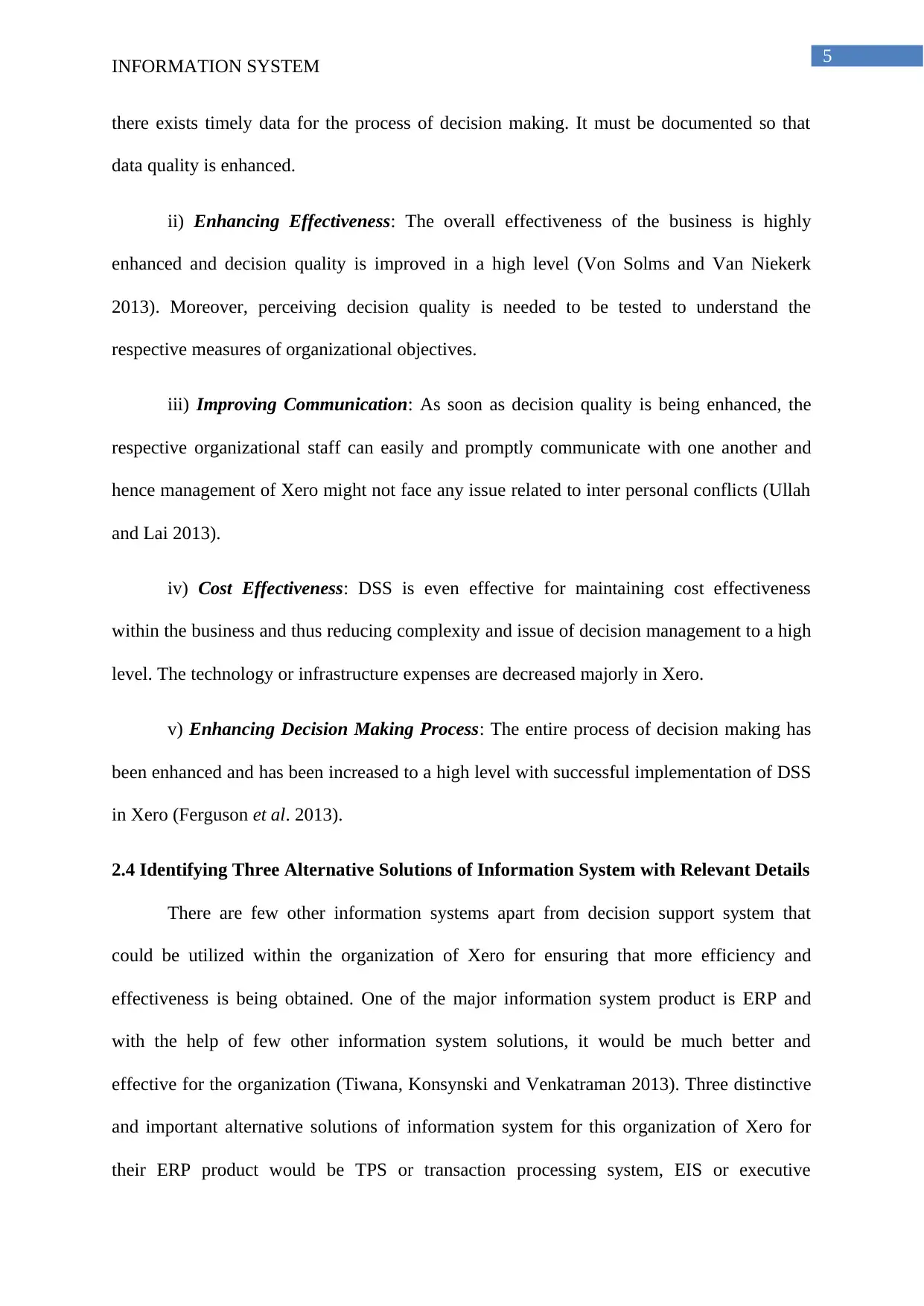
5
INFORMATION SYSTEM
there exists timely data for the process of decision making. It must be documented so that
data quality is enhanced.
ii) Enhancing Effectiveness: The overall effectiveness of the business is highly
enhanced and decision quality is improved in a high level (Von Solms and Van Niekerk
2013). Moreover, perceiving decision quality is needed to be tested to understand the
respective measures of organizational objectives.
iii) Improving Communication: As soon as decision quality is being enhanced, the
respective organizational staff can easily and promptly communicate with one another and
hence management of Xero might not face any issue related to inter personal conflicts (Ullah
and Lai 2013).
iv) Cost Effectiveness: DSS is even effective for maintaining cost effectiveness
within the business and thus reducing complexity and issue of decision management to a high
level. The technology or infrastructure expenses are decreased majorly in Xero.
v) Enhancing Decision Making Process: The entire process of decision making has
been enhanced and has been increased to a high level with successful implementation of DSS
in Xero (Ferguson et al. 2013).
2.4 Identifying Three Alternative Solutions of Information System with Relevant Details
There are few other information systems apart from decision support system that
could be utilized within the organization of Xero for ensuring that more efficiency and
effectiveness is being obtained. One of the major information system product is ERP and
with the help of few other information system solutions, it would be much better and
effective for the organization (Tiwana, Konsynski and Venkatraman 2013). Three distinctive
and important alternative solutions of information system for this organization of Xero for
their ERP product would be TPS or transaction processing system, EIS or executive
INFORMATION SYSTEM
there exists timely data for the process of decision making. It must be documented so that
data quality is enhanced.
ii) Enhancing Effectiveness: The overall effectiveness of the business is highly
enhanced and decision quality is improved in a high level (Von Solms and Van Niekerk
2013). Moreover, perceiving decision quality is needed to be tested to understand the
respective measures of organizational objectives.
iii) Improving Communication: As soon as decision quality is being enhanced, the
respective organizational staff can easily and promptly communicate with one another and
hence management of Xero might not face any issue related to inter personal conflicts (Ullah
and Lai 2013).
iv) Cost Effectiveness: DSS is even effective for maintaining cost effectiveness
within the business and thus reducing complexity and issue of decision management to a high
level. The technology or infrastructure expenses are decreased majorly in Xero.
v) Enhancing Decision Making Process: The entire process of decision making has
been enhanced and has been increased to a high level with successful implementation of DSS
in Xero (Ferguson et al. 2013).
2.4 Identifying Three Alternative Solutions of Information System with Relevant Details
There are few other information systems apart from decision support system that
could be utilized within the organization of Xero for ensuring that more efficiency and
effectiveness is being obtained. One of the major information system product is ERP and
with the help of few other information system solutions, it would be much better and
effective for the organization (Tiwana, Konsynski and Venkatraman 2013). Three distinctive
and important alternative solutions of information system for this organization of Xero for
their ERP product would be TPS or transaction processing system, EIS or executive
⊘ This is a preview!⊘
Do you want full access?
Subscribe today to unlock all pages.

Trusted by 1+ million students worldwide
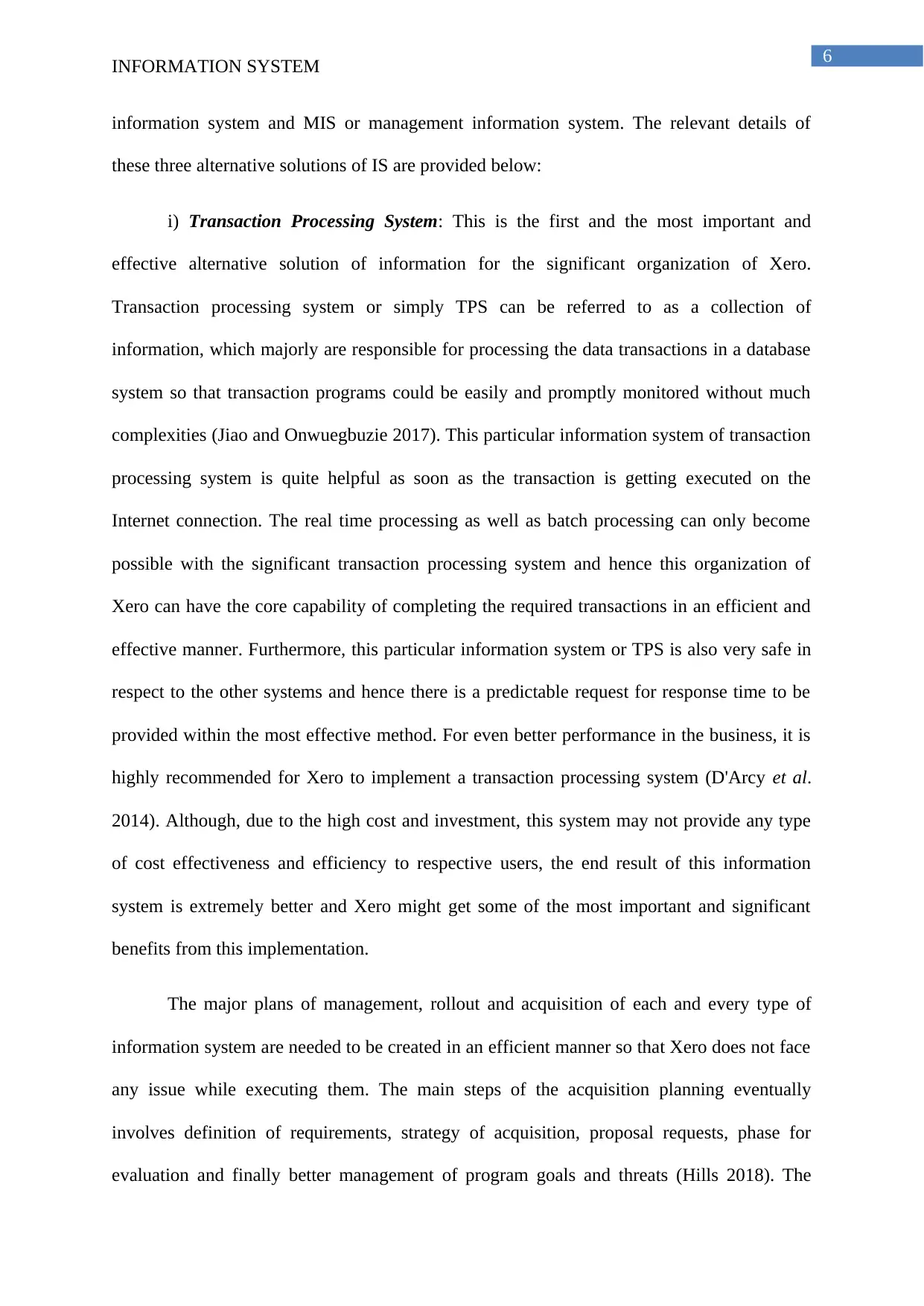
6
INFORMATION SYSTEM
information system and MIS or management information system. The relevant details of
these three alternative solutions of IS are provided below:
i) Transaction Processing System: This is the first and the most important and
effective alternative solution of information for the significant organization of Xero.
Transaction processing system or simply TPS can be referred to as a collection of
information, which majorly are responsible for processing the data transactions in a database
system so that transaction programs could be easily and promptly monitored without much
complexities (Jiao and Onwuegbuzie 2017). This particular information system of transaction
processing system is quite helpful as soon as the transaction is getting executed on the
Internet connection. The real time processing as well as batch processing can only become
possible with the significant transaction processing system and hence this organization of
Xero can have the core capability of completing the required transactions in an efficient and
effective manner. Furthermore, this particular information system or TPS is also very safe in
respect to the other systems and hence there is a predictable request for response time to be
provided within the most effective method. For even better performance in the business, it is
highly recommended for Xero to implement a transaction processing system (D'Arcy et al.
2014). Although, due to the high cost and investment, this system may not provide any type
of cost effectiveness and efficiency to respective users, the end result of this information
system is extremely better and Xero might get some of the most important and significant
benefits from this implementation.
The major plans of management, rollout and acquisition of each and every type of
information system are needed to be created in an efficient manner so that Xero does not face
any issue while executing them. The main steps of the acquisition planning eventually
involves definition of requirements, strategy of acquisition, proposal requests, phase for
evaluation and finally better management of program goals and threats (Hills 2018). The
INFORMATION SYSTEM
information system and MIS or management information system. The relevant details of
these three alternative solutions of IS are provided below:
i) Transaction Processing System: This is the first and the most important and
effective alternative solution of information for the significant organization of Xero.
Transaction processing system or simply TPS can be referred to as a collection of
information, which majorly are responsible for processing the data transactions in a database
system so that transaction programs could be easily and promptly monitored without much
complexities (Jiao and Onwuegbuzie 2017). This particular information system of transaction
processing system is quite helpful as soon as the transaction is getting executed on the
Internet connection. The real time processing as well as batch processing can only become
possible with the significant transaction processing system and hence this organization of
Xero can have the core capability of completing the required transactions in an efficient and
effective manner. Furthermore, this particular information system or TPS is also very safe in
respect to the other systems and hence there is a predictable request for response time to be
provided within the most effective method. For even better performance in the business, it is
highly recommended for Xero to implement a transaction processing system (D'Arcy et al.
2014). Although, due to the high cost and investment, this system may not provide any type
of cost effectiveness and efficiency to respective users, the end result of this information
system is extremely better and Xero might get some of the most important and significant
benefits from this implementation.
The major plans of management, rollout and acquisition of each and every type of
information system are needed to be created in an efficient manner so that Xero does not face
any issue while executing them. The main steps of the acquisition planning eventually
involves definition of requirements, strategy of acquisition, proposal requests, phase for
evaluation and finally better management of program goals and threats (Hills 2018). The
Paraphrase This Document
Need a fresh take? Get an instant paraphrase of this document with our AI Paraphraser
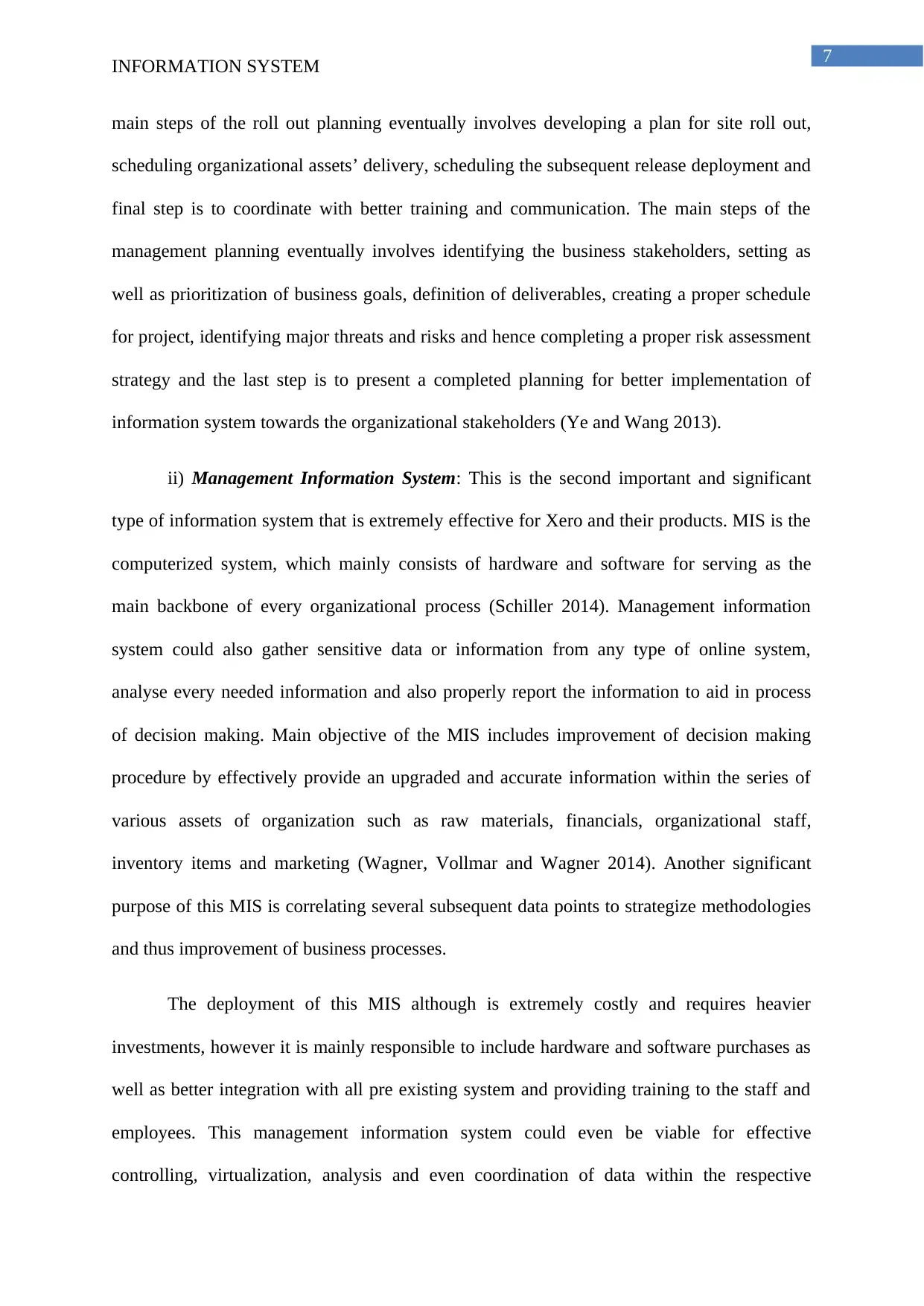
7
INFORMATION SYSTEM
main steps of the roll out planning eventually involves developing a plan for site roll out,
scheduling organizational assets’ delivery, scheduling the subsequent release deployment and
final step is to coordinate with better training and communication. The main steps of the
management planning eventually involves identifying the business stakeholders, setting as
well as prioritization of business goals, definition of deliverables, creating a proper schedule
for project, identifying major threats and risks and hence completing a proper risk assessment
strategy and the last step is to present a completed planning for better implementation of
information system towards the organizational stakeholders (Ye and Wang 2013).
ii) Management Information System: This is the second important and significant
type of information system that is extremely effective for Xero and their products. MIS is the
computerized system, which mainly consists of hardware and software for serving as the
main backbone of every organizational process (Schiller 2014). Management information
system could also gather sensitive data or information from any type of online system,
analyse every needed information and also properly report the information to aid in process
of decision making. Main objective of the MIS includes improvement of decision making
procedure by effectively provide an upgraded and accurate information within the series of
various assets of organization such as raw materials, financials, organizational staff,
inventory items and marketing (Wagner, Vollmar and Wagner 2014). Another significant
purpose of this MIS is correlating several subsequent data points to strategize methodologies
and thus improvement of business processes.
The deployment of this MIS although is extremely costly and requires heavier
investments, however it is mainly responsible to include hardware and software purchases as
well as better integration with all pre existing system and providing training to the staff and
employees. This management information system could even be viable for effective
controlling, virtualization, analysis and even coordination of data within the respective
INFORMATION SYSTEM
main steps of the roll out planning eventually involves developing a plan for site roll out,
scheduling organizational assets’ delivery, scheduling the subsequent release deployment and
final step is to coordinate with better training and communication. The main steps of the
management planning eventually involves identifying the business stakeholders, setting as
well as prioritization of business goals, definition of deliverables, creating a proper schedule
for project, identifying major threats and risks and hence completing a proper risk assessment
strategy and the last step is to present a completed planning for better implementation of
information system towards the organizational stakeholders (Ye and Wang 2013).
ii) Management Information System: This is the second important and significant
type of information system that is extremely effective for Xero and their products. MIS is the
computerized system, which mainly consists of hardware and software for serving as the
main backbone of every organizational process (Schiller 2014). Management information
system could also gather sensitive data or information from any type of online system,
analyse every needed information and also properly report the information to aid in process
of decision making. Main objective of the MIS includes improvement of decision making
procedure by effectively provide an upgraded and accurate information within the series of
various assets of organization such as raw materials, financials, organizational staff,
inventory items and marketing (Wagner, Vollmar and Wagner 2014). Another significant
purpose of this MIS is correlating several subsequent data points to strategize methodologies
and thus improvement of business processes.
The deployment of this MIS although is extremely costly and requires heavier
investments, however it is mainly responsible to include hardware and software purchases as
well as better integration with all pre existing system and providing training to the staff and
employees. This management information system could even be viable for effective
controlling, virtualization, analysis and even coordination of data within the respective
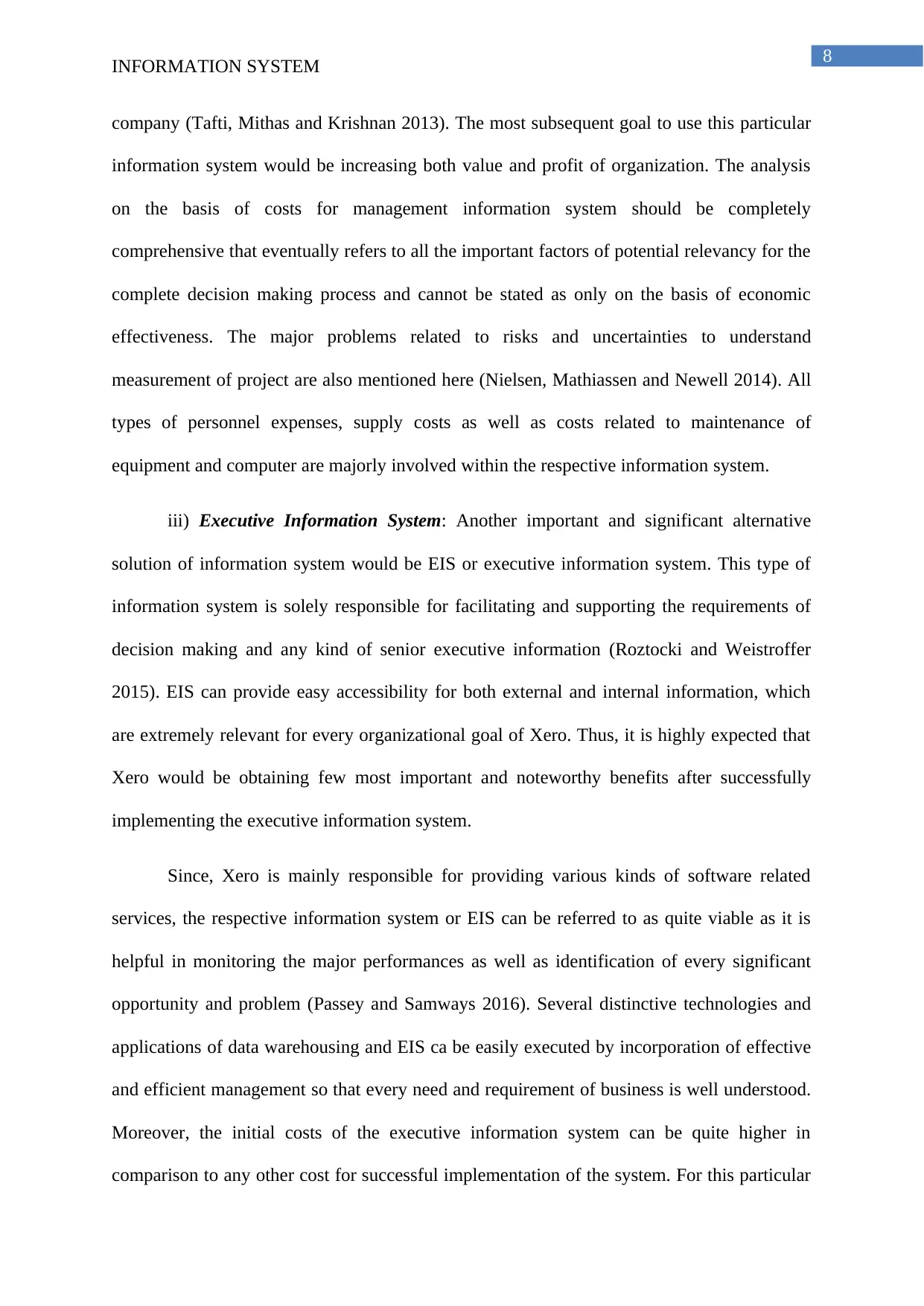
8
INFORMATION SYSTEM
company (Tafti, Mithas and Krishnan 2013). The most subsequent goal to use this particular
information system would be increasing both value and profit of organization. The analysis
on the basis of costs for management information system should be completely
comprehensive that eventually refers to all the important factors of potential relevancy for the
complete decision making process and cannot be stated as only on the basis of economic
effectiveness. The major problems related to risks and uncertainties to understand
measurement of project are also mentioned here (Nielsen, Mathiassen and Newell 2014). All
types of personnel expenses, supply costs as well as costs related to maintenance of
equipment and computer are majorly involved within the respective information system.
iii) Executive Information System: Another important and significant alternative
solution of information system would be EIS or executive information system. This type of
information system is solely responsible for facilitating and supporting the requirements of
decision making and any kind of senior executive information (Roztocki and Weistroffer
2015). EIS can provide easy accessibility for both external and internal information, which
are extremely relevant for every organizational goal of Xero. Thus, it is highly expected that
Xero would be obtaining few most important and noteworthy benefits after successfully
implementing the executive information system.
Since, Xero is mainly responsible for providing various kinds of software related
services, the respective information system or EIS can be referred to as quite viable as it is
helpful in monitoring the major performances as well as identification of every significant
opportunity and problem (Passey and Samways 2016). Several distinctive technologies and
applications of data warehousing and EIS ca be easily executed by incorporation of effective
and efficient management so that every need and requirement of business is well understood.
Moreover, the initial costs of the executive information system can be quite higher in
comparison to any other cost for successful implementation of the system. For this particular
INFORMATION SYSTEM
company (Tafti, Mithas and Krishnan 2013). The most subsequent goal to use this particular
information system would be increasing both value and profit of organization. The analysis
on the basis of costs for management information system should be completely
comprehensive that eventually refers to all the important factors of potential relevancy for the
complete decision making process and cannot be stated as only on the basis of economic
effectiveness. The major problems related to risks and uncertainties to understand
measurement of project are also mentioned here (Nielsen, Mathiassen and Newell 2014). All
types of personnel expenses, supply costs as well as costs related to maintenance of
equipment and computer are majorly involved within the respective information system.
iii) Executive Information System: Another important and significant alternative
solution of information system would be EIS or executive information system. This type of
information system is solely responsible for facilitating and supporting the requirements of
decision making and any kind of senior executive information (Roztocki and Weistroffer
2015). EIS can provide easy accessibility for both external and internal information, which
are extremely relevant for every organizational goal of Xero. Thus, it is highly expected that
Xero would be obtaining few most important and noteworthy benefits after successfully
implementing the executive information system.
Since, Xero is mainly responsible for providing various kinds of software related
services, the respective information system or EIS can be referred to as quite viable as it is
helpful in monitoring the major performances as well as identification of every significant
opportunity and problem (Passey and Samways 2016). Several distinctive technologies and
applications of data warehousing and EIS ca be easily executed by incorporation of effective
and efficient management so that every need and requirement of business is well understood.
Moreover, the initial costs of the executive information system can be quite higher in
comparison to any other cost for successful implementation of the system. For this particular
⊘ This is a preview!⊘
Do you want full access?
Subscribe today to unlock all pages.

Trusted by 1+ million students worldwide
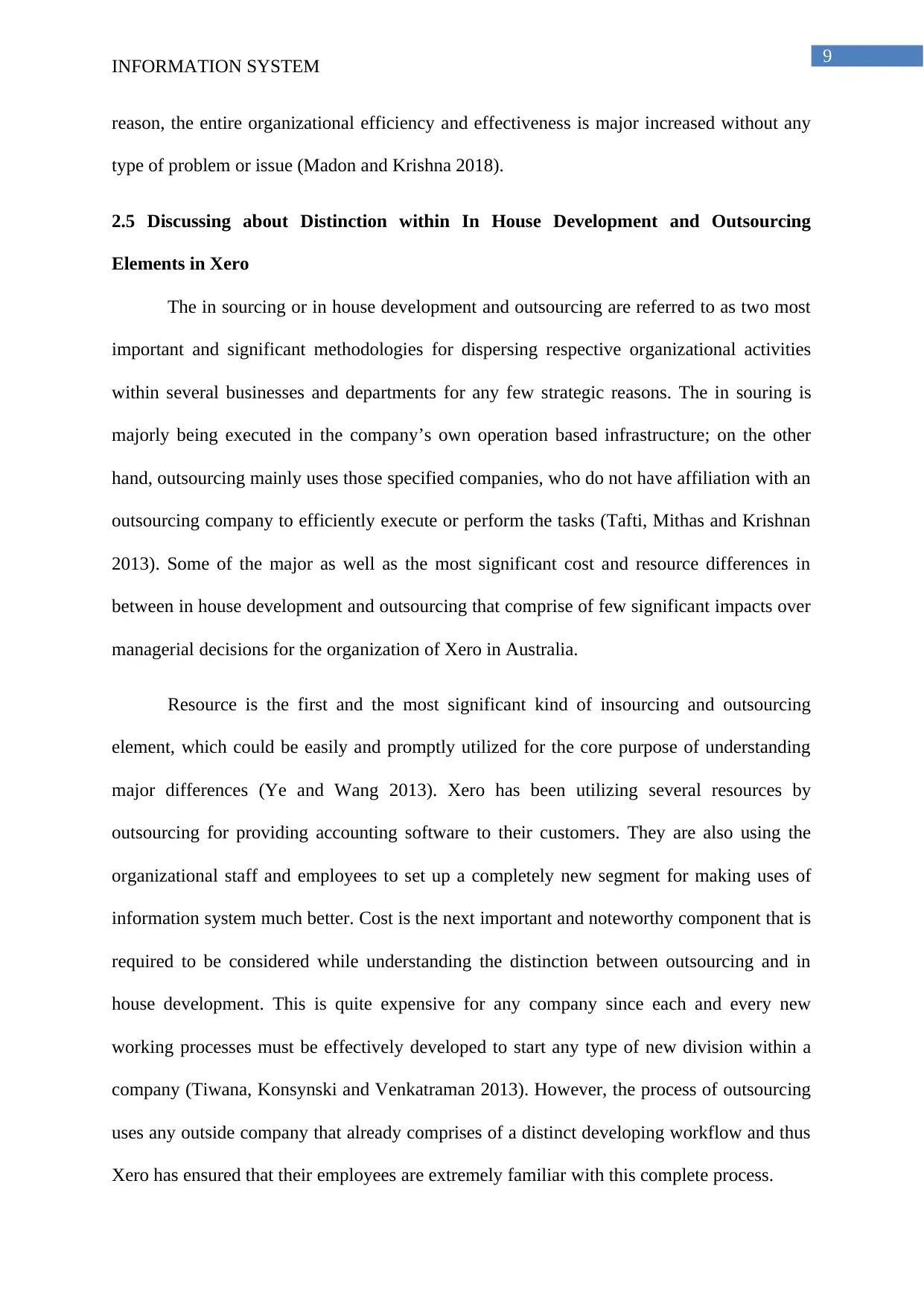
9
INFORMATION SYSTEM
reason, the entire organizational efficiency and effectiveness is major increased without any
type of problem or issue (Madon and Krishna 2018).
2.5 Discussing about Distinction within In House Development and Outsourcing
Elements in Xero
The in sourcing or in house development and outsourcing are referred to as two most
important and significant methodologies for dispersing respective organizational activities
within several businesses and departments for any few strategic reasons. The in souring is
majorly being executed in the company’s own operation based infrastructure; on the other
hand, outsourcing mainly uses those specified companies, who do not have affiliation with an
outsourcing company to efficiently execute or perform the tasks (Tafti, Mithas and Krishnan
2013). Some of the major as well as the most significant cost and resource differences in
between in house development and outsourcing that comprise of few significant impacts over
managerial decisions for the organization of Xero in Australia.
Resource is the first and the most significant kind of insourcing and outsourcing
element, which could be easily and promptly utilized for the core purpose of understanding
major differences (Ye and Wang 2013). Xero has been utilizing several resources by
outsourcing for providing accounting software to their customers. They are also using the
organizational staff and employees to set up a completely new segment for making uses of
information system much better. Cost is the next important and noteworthy component that is
required to be considered while understanding the distinction between outsourcing and in
house development. This is quite expensive for any company since each and every new
working processes must be effectively developed to start any type of new division within a
company (Tiwana, Konsynski and Venkatraman 2013). However, the process of outsourcing
uses any outside company that already comprises of a distinct developing workflow and thus
Xero has ensured that their employees are extremely familiar with this complete process.
INFORMATION SYSTEM
reason, the entire organizational efficiency and effectiveness is major increased without any
type of problem or issue (Madon and Krishna 2018).
2.5 Discussing about Distinction within In House Development and Outsourcing
Elements in Xero
The in sourcing or in house development and outsourcing are referred to as two most
important and significant methodologies for dispersing respective organizational activities
within several businesses and departments for any few strategic reasons. The in souring is
majorly being executed in the company’s own operation based infrastructure; on the other
hand, outsourcing mainly uses those specified companies, who do not have affiliation with an
outsourcing company to efficiently execute or perform the tasks (Tafti, Mithas and Krishnan
2013). Some of the major as well as the most significant cost and resource differences in
between in house development and outsourcing that comprise of few significant impacts over
managerial decisions for the organization of Xero in Australia.
Resource is the first and the most significant kind of insourcing and outsourcing
element, which could be easily and promptly utilized for the core purpose of understanding
major differences (Ye and Wang 2013). Xero has been utilizing several resources by
outsourcing for providing accounting software to their customers. They are also using the
organizational staff and employees to set up a completely new segment for making uses of
information system much better. Cost is the next important and noteworthy component that is
required to be considered while understanding the distinction between outsourcing and in
house development. This is quite expensive for any company since each and every new
working processes must be effectively developed to start any type of new division within a
company (Tiwana, Konsynski and Venkatraman 2013). However, the process of outsourcing
uses any outside company that already comprises of a distinct developing workflow and thus
Xero has ensured that their employees are extremely familiar with this complete process.
Paraphrase This Document
Need a fresh take? Get an instant paraphrase of this document with our AI Paraphraser
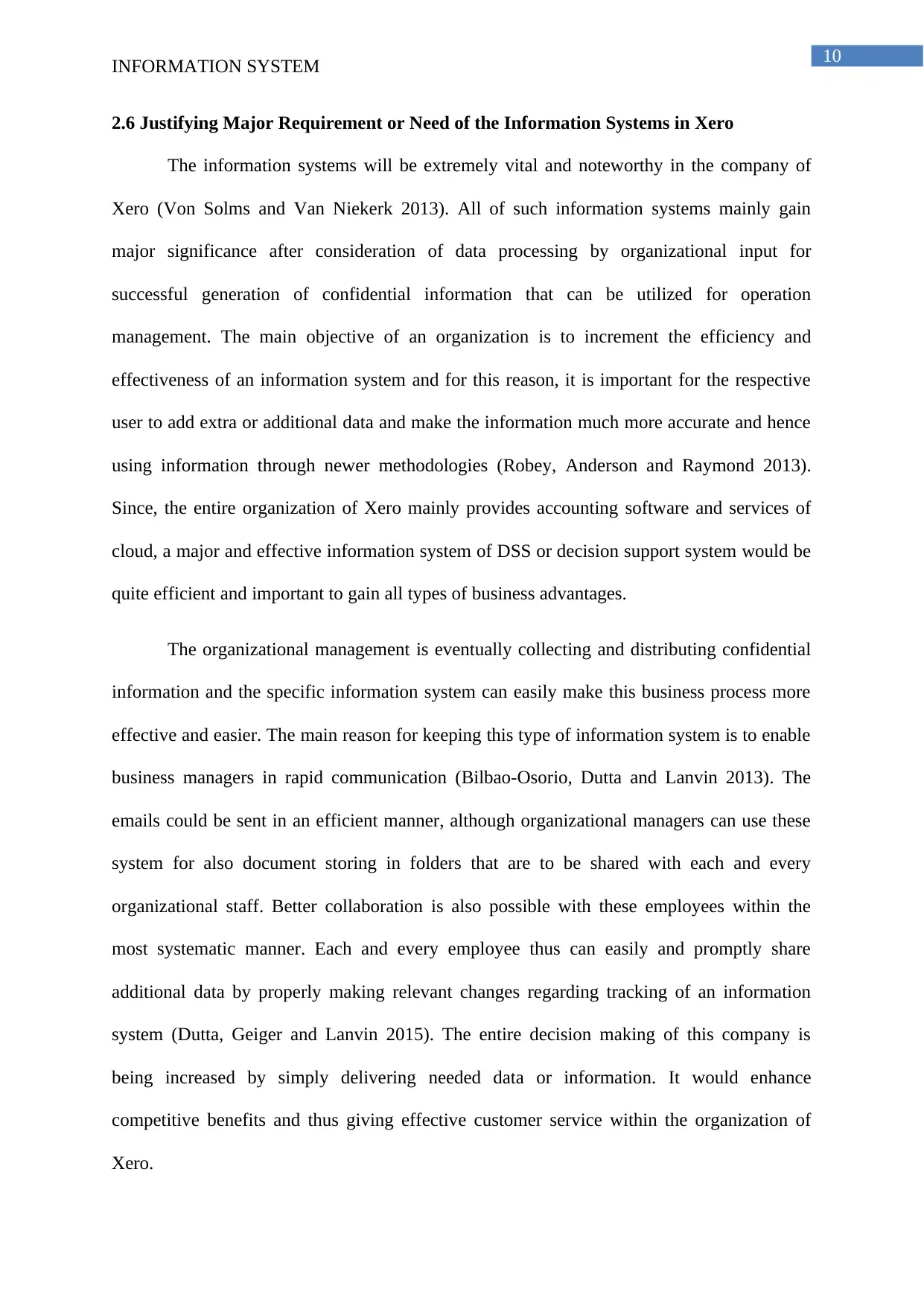
10
INFORMATION SYSTEM
2.6 Justifying Major Requirement or Need of the Information Systems in Xero
The information systems will be extremely vital and noteworthy in the company of
Xero (Von Solms and Van Niekerk 2013). All of such information systems mainly gain
major significance after consideration of data processing by organizational input for
successful generation of confidential information that can be utilized for operation
management. The main objective of an organization is to increment the efficiency and
effectiveness of an information system and for this reason, it is important for the respective
user to add extra or additional data and make the information much more accurate and hence
using information through newer methodologies (Robey, Anderson and Raymond 2013).
Since, the entire organization of Xero mainly provides accounting software and services of
cloud, a major and effective information system of DSS or decision support system would be
quite efficient and important to gain all types of business advantages.
The organizational management is eventually collecting and distributing confidential
information and the specific information system can easily make this business process more
effective and easier. The main reason for keeping this type of information system is to enable
business managers in rapid communication (Bilbao-Osorio, Dutta and Lanvin 2013). The
emails could be sent in an efficient manner, although organizational managers can use these
system for also document storing in folders that are to be shared with each and every
organizational staff. Better collaboration is also possible with these employees within the
most systematic manner. Each and every employee thus can easily and promptly share
additional data by properly making relevant changes regarding tracking of an information
system (Dutta, Geiger and Lanvin 2015). The entire decision making of this company is
being increased by simply delivering needed data or information. It would enhance
competitive benefits and thus giving effective customer service within the organization of
Xero.
INFORMATION SYSTEM
2.6 Justifying Major Requirement or Need of the Information Systems in Xero
The information systems will be extremely vital and noteworthy in the company of
Xero (Von Solms and Van Niekerk 2013). All of such information systems mainly gain
major significance after consideration of data processing by organizational input for
successful generation of confidential information that can be utilized for operation
management. The main objective of an organization is to increment the efficiency and
effectiveness of an information system and for this reason, it is important for the respective
user to add extra or additional data and make the information much more accurate and hence
using information through newer methodologies (Robey, Anderson and Raymond 2013).
Since, the entire organization of Xero mainly provides accounting software and services of
cloud, a major and effective information system of DSS or decision support system would be
quite efficient and important to gain all types of business advantages.
The organizational management is eventually collecting and distributing confidential
information and the specific information system can easily make this business process more
effective and easier. The main reason for keeping this type of information system is to enable
business managers in rapid communication (Bilbao-Osorio, Dutta and Lanvin 2013). The
emails could be sent in an efficient manner, although organizational managers can use these
system for also document storing in folders that are to be shared with each and every
organizational staff. Better collaboration is also possible with these employees within the
most systematic manner. Each and every employee thus can easily and promptly share
additional data by properly making relevant changes regarding tracking of an information
system (Dutta, Geiger and Lanvin 2015). The entire decision making of this company is
being increased by simply delivering needed data or information. It would enhance
competitive benefits and thus giving effective customer service within the organization of
Xero.
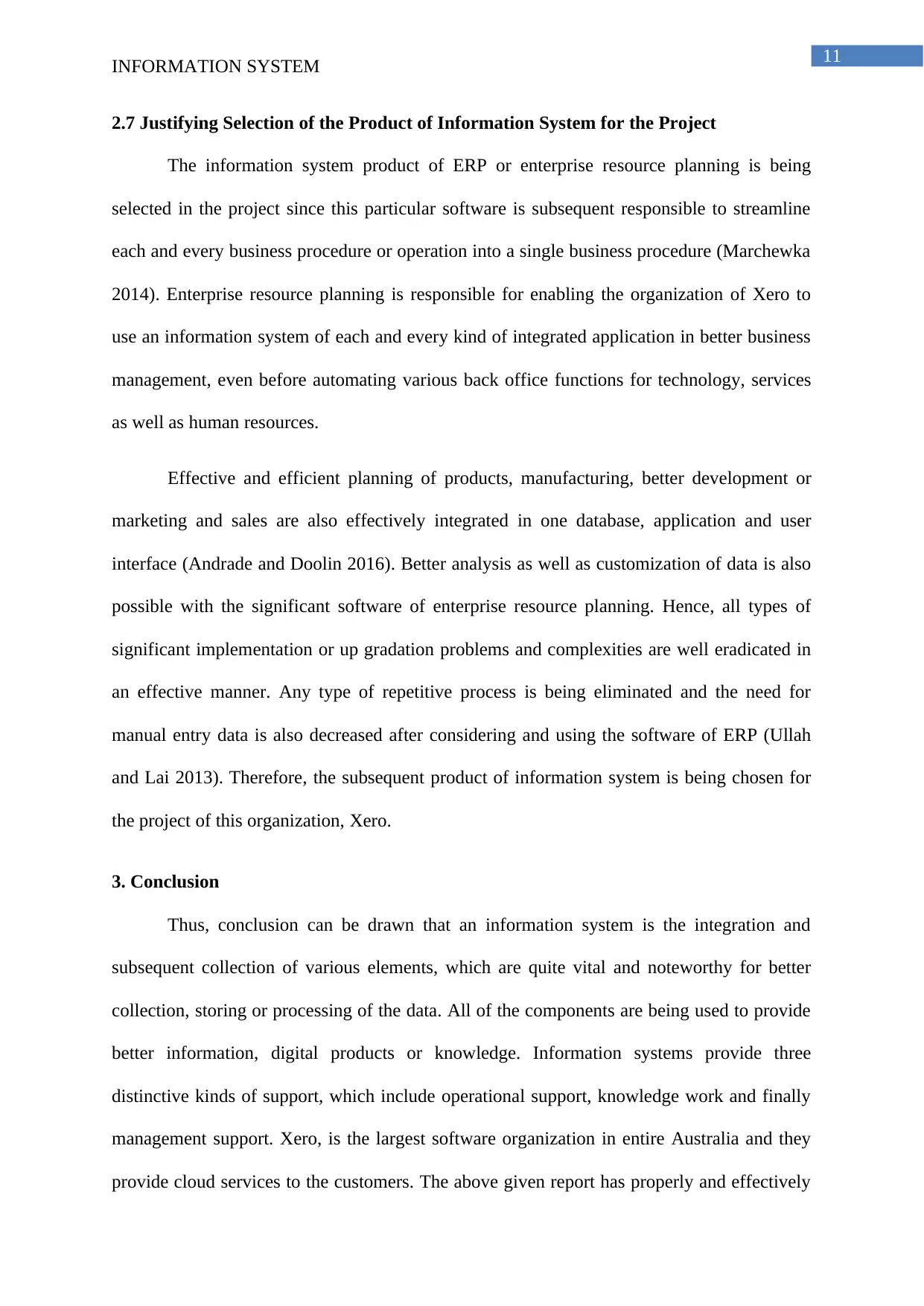
11
INFORMATION SYSTEM
2.7 Justifying Selection of the Product of Information System for the Project
The information system product of ERP or enterprise resource planning is being
selected in the project since this particular software is subsequent responsible to streamline
each and every business procedure or operation into a single business procedure (Marchewka
2014). Enterprise resource planning is responsible for enabling the organization of Xero to
use an information system of each and every kind of integrated application in better business
management, even before automating various back office functions for technology, services
as well as human resources.
Effective and efficient planning of products, manufacturing, better development or
marketing and sales are also effectively integrated in one database, application and user
interface (Andrade and Doolin 2016). Better analysis as well as customization of data is also
possible with the significant software of enterprise resource planning. Hence, all types of
significant implementation or up gradation problems and complexities are well eradicated in
an effective manner. Any type of repetitive process is being eliminated and the need for
manual entry data is also decreased after considering and using the software of ERP (Ullah
and Lai 2013). Therefore, the subsequent product of information system is being chosen for
the project of this organization, Xero.
3. Conclusion
Thus, conclusion can be drawn that an information system is the integration and
subsequent collection of various elements, which are quite vital and noteworthy for better
collection, storing or processing of the data. All of the components are being used to provide
better information, digital products or knowledge. Information systems provide three
distinctive kinds of support, which include operational support, knowledge work and finally
management support. Xero, is the largest software organization in entire Australia and they
provide cloud services to the customers. The above given report has properly and effectively
INFORMATION SYSTEM
2.7 Justifying Selection of the Product of Information System for the Project
The information system product of ERP or enterprise resource planning is being
selected in the project since this particular software is subsequent responsible to streamline
each and every business procedure or operation into a single business procedure (Marchewka
2014). Enterprise resource planning is responsible for enabling the organization of Xero to
use an information system of each and every kind of integrated application in better business
management, even before automating various back office functions for technology, services
as well as human resources.
Effective and efficient planning of products, manufacturing, better development or
marketing and sales are also effectively integrated in one database, application and user
interface (Andrade and Doolin 2016). Better analysis as well as customization of data is also
possible with the significant software of enterprise resource planning. Hence, all types of
significant implementation or up gradation problems and complexities are well eradicated in
an effective manner. Any type of repetitive process is being eliminated and the need for
manual entry data is also decreased after considering and using the software of ERP (Ullah
and Lai 2013). Therefore, the subsequent product of information system is being chosen for
the project of this organization, Xero.
3. Conclusion
Thus, conclusion can be drawn that an information system is the integration and
subsequent collection of various elements, which are quite vital and noteworthy for better
collection, storing or processing of the data. All of the components are being used to provide
better information, digital products or knowledge. Information systems provide three
distinctive kinds of support, which include operational support, knowledge work and finally
management support. Xero, is the largest software organization in entire Australia and they
provide cloud services to the customers. The above given report has properly and effectively
⊘ This is a preview!⊘
Do you want full access?
Subscribe today to unlock all pages.

Trusted by 1+ million students worldwide
1 out of 16
Related Documents
Your All-in-One AI-Powered Toolkit for Academic Success.
+13062052269
info@desklib.com
Available 24*7 on WhatsApp / Email
![[object Object]](/_next/static/media/star-bottom.7253800d.svg)
Unlock your academic potential
Copyright © 2020–2025 A2Z Services. All Rights Reserved. Developed and managed by ZUCOL.



